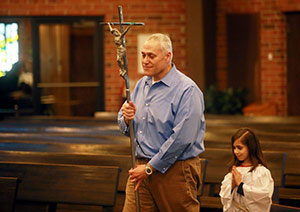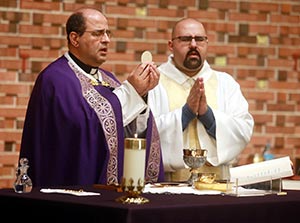St. Sebastian Parish, Sturtevant, has welcomed a different style of worship since December. Twice a month, the parish is home to the Maronite Catholic Community, which hopes to build its own parish in the Milwaukee Archdiocese.
The Maronites are one of 22 Catholic Churches in the world, comprise one of 21 Eastern Rite Catholic  Raymond Dandan, followed by 6-year-old Myrian Dandan, enters St. Sebastian Parish, Sturtevant, on March 30 for a celebration of the Divine Liturgy by the newly formed local Maronite Catholic Community. (Catholic Herald photo by Allen Fredrickson)groups, and are descendants of Christian communities established throughout the Middle East by the early church.
Raymond Dandan, followed by 6-year-old Myrian Dandan, enters St. Sebastian Parish, Sturtevant, on March 30 for a celebration of the Divine Liturgy by the newly formed local Maronite Catholic Community. (Catholic Herald photo by Allen Fredrickson)groups, and are descendants of Christian communities established throughout the Middle East by the early church.
Other examples are Coptics in Egypt and Chaldeans in Iraq. Eastern Rite Catholics are not Roman Catholics, but are under the authority of the Holy Father.
The majority of Christians in Lebanon are Maronite Catholics; they celebrate an ancient form of liturgy that has changed little in 16 centuries. The Mass, or Divine Liturgy, is in English, Arabic and Aramaic, the language Jesus spoke. The Bible records that followers of Christ were first called Christians in Antioch and the Apostle Paul and Barnabas preached there.
Maronites take their name from St. Maron, a member of the early Antiochan church who moved to the mountains and became a hermit.
Hope to reestablish roots
Fr. Sharbel Maround, pastor of St. Maron in Minneapolis, one of the priests forming this new community,
IF YOU WOULD LIKE TO ATTEND:Maronite Divine Liturgy St. Sebastian Parish For information: |
admitted the Eastern Catholic Church is not well known in the Milwaukee area, but hopes it will grow as Middle Eastern Catholics re-establish their roots.
“I feel joyous and lucky to be part of a parish giving birth to a new church, and I share time there with three other priests,” said the Lebanese native during a phone conversation. “I serve sort of as the dean of our region and oversee the community there.”
The United States consists of 100 Maronite parishes and approximately 10 mission churches within two Eparchies (dioceses), the Eparchy of Los Angeles and the Eparchy of St. Louis. Worldwide, 3 to 4 million Catholics are members of the Maronite Church and approximately 100,000 reside in the United States. Because there are so few Maronite churches in the United States, however, many do not realize their cultural ties to the faith.
Under authority of same pope
“When I look around in my home parish, I see not only Lebanese, but Syrians, Egyptians, Iraqis, Armenians, Chaldeans and Greeks in our pews on Sundays. We also have plenty of members of the Irish community,” said Fr. Maround. “If you take a survey in America, 98 percent of American Catholics don’t know that there is another branch of Catholicism and they think Roman Malachite means Catholic. But the Catholic Church is all of us united together in the same faith and the same sacraments and under the same authority of the pope. Our church is like a mosaic of 22 pieces and if you take away the 21 pieces, you only have one piece left and that does not show the entire picture.”
 Fr. Pierre Albalaa, left, and Fr. Nayef Alzainaty say the prayers of consecration during Divine Liturgy at St. Sebastian Parish, Sturtevant, March 30. The Maronite Catholic Community began worshipping at St. Sebastian in December. (Catholic Herald photo by Allen Fredrickson)On Aug. 15, 1991, Pope John Paul II stood on a platform before the shrine of Our Lady of Czestochowa at World Youth Day and celebrated Mass. He likened the church to a body with one east lung and one west lung and it takes two lungs to function at its best. This knowledge gap exists in spite of Pope John Paul II’s urging that the Catholic Church “breathe with two lungs” – East and West alike – rather than with only one Western, or Latin, lung.
Fr. Pierre Albalaa, left, and Fr. Nayef Alzainaty say the prayers of consecration during Divine Liturgy at St. Sebastian Parish, Sturtevant, March 30. The Maronite Catholic Community began worshipping at St. Sebastian in December. (Catholic Herald photo by Allen Fredrickson)On Aug. 15, 1991, Pope John Paul II stood on a platform before the shrine of Our Lady of Czestochowa at World Youth Day and celebrated Mass. He likened the church to a body with one east lung and one west lung and it takes two lungs to function at its best. This knowledge gap exists in spite of Pope John Paul II’s urging that the Catholic Church “breathe with two lungs” – East and West alike – rather than with only one Western, or Latin, lung.
“Our church is not Slovak, not Greek, not Ukraine, not Maronite and not Roman,” said Fr. Maround.
“We all belong to this church and that is what makes it Catholic. St. John XXIII, at the opening of Vatican II, urged Eastern Rite churches to dig out their tradition and share it with others. He said ‘what you have does not belong to you, it belongs to all of us.’”
Tradition blurred into Roman rite
Before Vatican II, many churches were oppressed and losing their identity because after immigrating to America, they were persecuted, explained Fr. Maround. The Maronites, in an effort to prove they were Catholic, adopted many of the Latin rites, including vestments, Roman books, eucharistic prayers and Stations of the Cross. Much of the richness of their tradition blurred into the Roman Rite and their uniqueness faded.
“Vatican II said that we needed to purify our tradition and bring reality to who we are,” said Fr. Maround. “If you come to our Divine Liturgy, you would witness the faith that binds us together. We have a mixture of Aramaic, Arabic and English, but it is easy to follow because we have everything on the right pages, translated into English and some into Aramaic. If you don’t understand the words, or the music, it doesn’t matter as you are drawn in an incredible way.”
Many Middle Eastern Catholics immigrated to the United States during the Civil War in Lebanon, 1975-90, the Iraqi Wars, Syrian Civil War, etc., and when they found few Eastern Catholic Churches in the United States, merged into Roman Catholic parishes or non-denominational churches.
Closest church 90 minutes away
According to Lebanese born Vera Maalouf, the mission church’s coordinator, before this new community formed, the only Maronite Church in the area was in Lombard, Ill., a 90-minute drive each way.
“It was such a long drive for us and the kids complained, so most of the times we would attend a local Roman Catholic Church in Kenosha,” she explained in a phone conversation. “But I grew up in the church and felt that if we joined the Roman Catholic Church that we would lose our identity and our traditions.”
Since she grew up and celebrated all of the sacraments in the Maronite Church, she felt it important that her children and other Middle Eastern Catholics be given the same opportunity to worship in the culture they were raised.
About eight years ago, she contacted the now-retired Maronite Bishop Joseph Shaheen in the Eparchy of St. Louis to see if there could be a parish formed in the Southeastern Wisconsin area to accommodate members from the Milwaukee, Racine, Kenosha and northern Illinois areas.
“I was told that we could absolutely begin a new parish, but the issue was with the lack of priestly vocations,” she said. “We planted a seed, but then I wasn’t able to follow through with it because my husband’s job relocated us to Switzerland for a while.”
Archbishop ‘overwhelmingly’ supportive
When she arrived home last year, she spoke with the newly elected bishop of the St. Louis Eparchy, Bishop Elias Zaidan, who was excited with the prospect of adding a faith community. Maalouf and Bishop Zaidan contacted Archbishop Jerome E. Listecki about bringing a community into the archdiocese, and were pleased at his overwhelming support.
“He gave us his blessing and said we could start looking for a Catholic Church in the area to meet a couple of times a month,” she said. “After Bishop Elias began looking, we were happy that Fr. Mark Jones, the pastor of St. Sebastian, was so wonderful and welcoming to us. He said that we could absolutely use the church and that they only had an early morning Mass on Sunday.”
Average attendance is approximately 50-60 people, with 25 registered families. Bishop Elias appointed four priests to rotate Sunday Masses. Several cultures are represented at Sunday Mass, and Maalouf encourages all Catholics to experience the beauty of the Maronite liturgy.
“It is important for all of us to get to know the awareness of Christians in the Middle East and it will help in understanding the various misconceptions,” she said. “We have to, for the sake of the church, grow and come together as one church.”
After his appointment by Pope Francis last July, Bishop Zaidan was installed as bishop of the St. Louis Eparchy on Oct. 23. He was ordained in his home country of Lebanon in 1986 and came to the United States two years later to serve the Congregation of Maronite Lebanese Missionaries.
Catholics invited to Divine Liturgy
“We need to receive them with open arms and assist them in any way we can,” Bishop Zaidan said. “We need to be present for the people in their journey toward God. The pope has been emphasizing the ministry of charity and we have to do that as a church.”
While people are rediscovering their Eastern Catholic roots, a priest shortage precludes the planting of many new mission churches. Bishop Zaidan hopes with additional presence of the church more children will be attracted to a life of service in the church, as priests, nuns or monks of the Maronite Church.
“I do hope we get more seminarians and that husbands and wives will plant the seeds and support their children to the religious life,” he said. “If God grants me this in my episcopacy, I would like to have 25 more parishes and a 60 percent increase in priests.”
Bishop Zaidan will preside at St. Sebastian Parish on Sunday, May 4. He invites Catholics to join him for the Divine Liturgy.
“We are here to serve our people, to keep them and live their tradition and practice our faith, liturgy and reach out to as many people as possible,” he said. “We are so grateful to Archbishop Listecki for allowing us to grow in the Milwaukee Diocese.”
